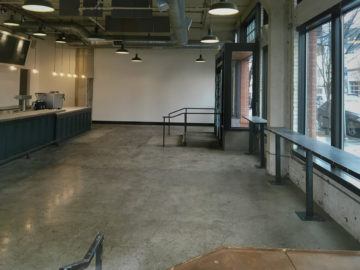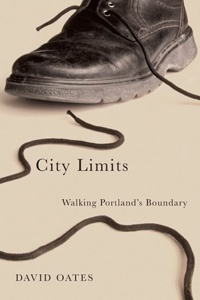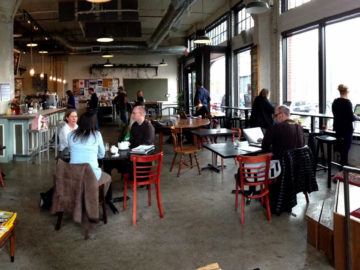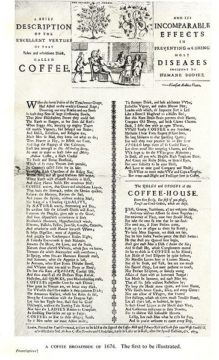by David Oates
 An empty space sits where I once sat. I miss it. I miss the strangers I shared it with, and a few regulars with whom I achieved a nodding relationship. A couple of baristas I might greet and chat up. Very briefly.
An empty space sits where I once sat. I miss it. I miss the strangers I shared it with, and a few regulars with whom I achieved a nodding relationship. A couple of baristas I might greet and chat up. Very briefly.
I miss the space itself – long and wide, its tall ceiling held up by industrial concrete pillars of old-fashioned ornateness reflecting its Model-T era use as a Ford manufactory. The space gave room to think and to be connected yet anonymous, with big tables for groups and – the star attraction for me – counter tables all along the windows where for years I have sat for my afternoon writing and reading. Getting lost in a poem or a book. Jotting a few words experimentally, or working on a chapter in progress. Gazing idly at someone at a sidewalk table (peeking at a book title if I can see it). Taking in the rush of cars and trucks, heading towards their 4:30 gridlock.
Strangers walk by with dogs, or with addictions, or with clothes nicer than I even know the words for. They all make me think. . . of what? Hard to say. How much I like a kind face, or a handsome one. Or an old one with lines.
What unknowabilities we all are.
But this space now sits plague-emptied, closed down apparently permanently. Here I wrote large pieces of my last book. And the one before it. I relied on this perfect one-mile walk from my home, an afternoon leg-stretch, a change of scenery, a change of mind. A way to feel connected to the humans. (But not too connected.)
This sociable, urbane space was a bit of what is called the “New Urbanism,” a thing for which Portland, Oregon had become renowned. But New Urbanism is shut down now. Public spaces empty. Restaurants shuttered. Transit deserted.
As if all that was left us was to revert to the 1950s and move back to the suburbs, isolated and safe, bourgie and dull. For the plague, we fear, may be killing cities as well as individuals.
* * *
In the U.S., New Urbanism originated as a retort to suburban sprawl, an invitation to rediscover the interesting, diverse, dense city. Since the 1930s, government policy at many levels had (more or less silently) supported and subsidized the emptying-out of the metropolis in favor of the dispersed, single-family “American Dream.” Federal mortgage support for homeowners, and Federal highways to whisk them away from the big bad city, were only the most obvious elements in this decades-long turn away from town. Common sense of that era assumed that neatly zoning like with like would make for efficient and healthful living – industry here, stores and shops there, and housing way, way over there. With the automobile, of course, to connect them all. (The bass note of racism of course can be heard under it all – this was above all “white flight.” But few in public life were willing to notice or care.)
But in the 1970s an alternative to suburbia began to be formulated:
“In contrast, New Urbanist projects were expected to promote mixed-use, mixed-income, compact developments that integrated a variety of housing types and supported alternative modes of transportation.”
What if you could live close to where you worked and ditch the commute? And what if your street were inviting and walkable, with groceries and banks and cafés an easy stroll away – or a quick transit ride? What if you lived near theaters, music. . . life. . . instead of isolated from it?
In just a few decades this vision became a reality in many American cities, so that we might not quite recall what a starkly contrarian reimagining it was. Though of course European cities had been doing urbanism all along, charming the goggle-eyed Americanos with sitting right by the sidewalk, with an espresso! And all the rest of the centre-ville charm that we thought one could only experience on an expensive, probably once-in-a-lifetime overseas vacation.
And a few giant American metropolises had certainly always maintained some of their old-world ways. New York and San Francisco were as exotic as Paris and Barcelona to kids like me from the suburbs. By the early 1980s it was clear that mid-sized towns could do it too. Soon Minneapolis and Pittsburgh and Denver and Portland were building newly revitalized downtowns. Compact, walkable, diverse, and with good transit: New-Urbanist all the way.
As a lovely historical irony, the successful new-urbanist experiments of these little-town bergs in turn gave a boost back to the old cities. When I visited New York from time to time, or when I lived in Paris for part of a year, I was charmed to see that new-urbanist tactics perfected in provincial capitals like Portland had circled back around and were influencing dramatic changes in the old big cities: Waterfront revitalization. Bike streets. Greenways. Avenues newly rescued from automotive domination, with tiny oases of green along the edges, little nooks for humans-not-in-cars: To sit. To sip. To be invited.
And let’s not forget the less-obvious payoff from this vision of urban liveliness in general. Propinquity – being alongside of and near to others – can enrich the life of the spirit too. Music is largely a communal art form, and being able to catch a combo at a night club, or a chamber-music evening, or a choral concert, a favorite band, a soloist – what price, Reader, to put on such things? For me they feel essential. Dance, visual art, theater, these too thrive when people are around to see and love and support them. They are mostly urban art forms. Meanwhile, there’s the less obvious cross-pollination of the mind: writers talking to writers, thinkers to thinkers, engineers and inventors and designers striking sparks off each other, or joining up collaboratively.
It’s been observed that the fundamental sign of the city is the simplest thing imaginable: an X. A crossroads. The place where surprise and enrichment come from unknown directions and bump into each other. It’s the otherness of the city – just what rural fundamentalists and defensive provincials hate. Other kinds of people. New ideas. New combinations arising willy-nilly.
* * *
But now, in early 2021, the pandemic has simply clobbered much of this investment in density and togetherness – dismantled it almost point-by-point, like a devil’s advocate undertaking a thorough rebuttal. Density? You’re paying for it now. Shared transit? No way. Apartments crowded close upon each other? Trapped. Encountering other people randomly?!? AHA HA HA HA…. cue the diabolical laughter.
To cite just a little evidence of the sudden collapse of urbanism: New York City’s subway system is presently carrying only about thirty percent of its normal daily load. And its leaders are not sure when, if ever, full pre-pandemic ridership may resume. Can a big city even work without transit? Probably not.
The countermove to the pandemic seems to be, for those who can afford it, to seek suburban-like isolation and family-castle solidarity. Escaping the city, with its crowds and contagion, is one of the oldest responses to plagues of all kinds. Whether they be ancient Roman or Renaissance Italian or sixteenth-century English, the wealthy simply decamp for the country until the danger is past. Giovanni Boccaccio’s early-Renaissance masterpiece Decameron features ten young people sent to a country villa to wait out the plague of 1348. In their boredom and entrapment (how well we recognize this set-up!), they undertake to tell stories to each other: ten each, a book’s worth. (So would we, perhaps, if we didn’t have devices.)
So, is a return to the suburbs (or beyond) in the making?
Andres Duany, one of the co-founders of the Congress for New Urbanism (CNU), has publicly spoken about the ways the pandemic has upended New Urbanism. Speaking in a CNU-sponsored event, he asked “Will New Urbanism find itself in the trash heap of history?” and identified a number of pandemic-inspired design principles that might bring a sort of revised suburbanism into city design: prominent garages (that can be multipurposed), single family dwellings, and the like. It’s a pretty astounding reversal of much that New Urban design has spent the last forty years championing. The future here guessed at will need a different name. Post-New-Urbanist, I suppose. Or Neo-Suburban?
* * *
When I moved here thirty years ago from my hometown of Los Angeles, Portland seemed, well, cute. It was certainly little, compared to the unbounded sprawl, fifty or a hundred miles in every direction, that I was accustomed to. Instead of gridlocked freeways Portland had light rail, and was busily installing street cars that meandered right through close-in neighborhoods that were diversifying mixes of old single-family homes, apartment buildings, and rather sleek mid-rise condo towers.
Every neighborhood I looked at had its own little four corners or two blocks of shops and cafes, charming and human-scaled. Food and drink seemed important here – always some buzz about a new pinot noir from an Oregon vineyard, a new espresso bar, new restaurant, even cluster of foodcarts offering cheap, excellent sidewalk eatin’. Most of it really wasn’t fancy – there’s never been a lot of money in Portland. But there was a real sensibility about living well.
We (how soon I included myself!) – we knew we weren’t global powerhouse Seattle, weren’t sprawling LA or hip San Francisco. We were a hidden gem. And urban planning was right at the heart of this sense of ourselves as a new kind of American town. Smaller, more limber, better planned, more human.
The more I investigated this Portland consciousness, this difference, the more surprised I was. It turned out that Oregonians had voted themselves a form of anti-sprawl governance, a communal control of land-use without equal in all of North America. It came in through a direct-vote ballot proposition in the mid-1970s, requiring every town and city to define an “urban growth boundary” (UGB). And it restricted dense urban land-use to areas within the UGBs; outside of the boundary, lands were to continue as forest, farm, orchard, vineyard, open space. No suburbs leapfrogging out into the countryside. No dilute urbanization sprawling loosely from one town to the next along the highways.
The Oregon system is positively unAmerican – and I mean this in the best way. Instead of allowing private interests free reign to make land-use decisions – determining how this naturally beautiful state would develop and how it would look to the next generations – citizens of Oregon took communal control. A state agency enforced the law. Local municipalities administered it Within the UGB of course lots of money was still to be made. But outside of it: open space and agriculture. Forever.
It was not an anti-growth measure. The UGB must be updated and redrawn at regular intervals, and cities are required to maintain inventories of buildable land for expansion. But lands to be sacrificed to growth are chosen with an eye on the core value: maintaining agricultural land for agriculture, forest for forest, vineyard for vineyard. While, conversely, promoting good, dense, urban cities.
In this radical way, growth is made thoughtful, intentional: managed for the greater good, not wangled for a lucky few to make windfall profits.
* * *
As I got the feel of my new hometown in the 1990s, I noticed that delegations from other municipalities around the country and around the world were coming to see how Portland did it. We were the New Urbanist poster child, proud to show off our new, compact, well-functioning town. We had, I’d say, a rather elevated view of ourselves.
But when I looked back at Portland before the land-use revolution, I saw that Portland really had been an undistinguished little town. Provincial, small, not that interesting. Somehow the spark of intentionality and communality had ignited a little renaissance here – the arts, for instance, have continued to play more like those of a town of double or quintuple Portland’s size. Pretty good theater. Excellent classical music. And I know its book culture first hand – thriving and influential.
So I undertook a project to try to really grasp and make immediate the rather wonky abstractions of “land-use planning.”
Part of the revolution in Oregon was to create a new level of government to unify all the disparate municipalities of the Portland urban area: it is a body called Metro, poised over thirty-some towns, cities, and counties, administering the UGB and making collaborative decisions about parks, transit, and the like. Metro has a map department, and there I found smart, eager civil servants, happy to tell me stories and sell me a couple of maps detailing the whole encircling line of demarcation: city on one side, country on the other.
 And thus equipped, I undertook a stunt: to walk the whole boundary, all 260 miles of it. To talk to homeowners and renters, activists and shop-owners and random folks all along the way. And (of course) to write about it. To see first hand, in the flesh, what had transformed this town.
And thus equipped, I undertook a stunt: to walk the whole boundary, all 260 miles of it. To talk to homeowners and renters, activists and shop-owners and random folks all along the way. And (of course) to write about it. To see first hand, in the flesh, what had transformed this town.
I’m a long-legged guy and walking comes easily to me. And really, the whole UGB walking project concealed a kind of private joke. For I got my start as what’s called a “nature writer,” drawing on decades of hiking and climbing in the Sierras and other remote and wild places. My first several books wrestled with concepts of nature, environment, and the challenges they present to our industrial/commercial values and decisions.
But when I had moved to Portland, suddenly the old John-Muir-inflected dichotomy of “wilderness versus civilization” seemed outworn. I wanted to bring my perspective back into the midst of how we actually lived – not just write about where we visited, briefly, when we could get away. And so I brought my skills to town: I did an urban trek.
I was in no hurry. Sometimes only one day of walking per week (I had a full-time teaching job and had to meter my time and energy). Usually I went about ten miles, talking and jotting, then called a cab to take me back to my car or starting point. I saw plenty of picturesque views – country corn fields or berry fields that came right up to a line of apartments, shops, and homes. Just like that. Silos glinting in middle distance; skateboards and sidewalks behind me.
I dug in and found contradictions. Ways the system was pinching some, benefitting others. I heard a few gripes. Yet for the most part people on the boundary were pretty happy about it. Best of both worlds, I guess. I was on hand for some of the UGB’s near-death experiences, when pro-development forces challenged it with repeated statewide votes. They actually won once. But in the next round, the populace turned with a vengeance against the developers. What changed? Well, in the two years between elections, voters saw that what they had okayed in the anti-UGB ballot measure wasn’t just “freedom” or “free enterprise,” but actual condos and suburban tract housing replacing orchards, vineyards, and deep-green fir and cedar forests. The second vote, restoring the UBG status quo, wasn’t even close.
Oregonians have a deep connection to their beautiful state, its rivers, forests, deserts, coasts and mountains — and have often moved in surprisingly progressive ways to protect and cherish them. The creation of this public-spirited land-use system was a tangible way to institutionalize this love.
For this urbanism isn’t just a way of stacking up buildings. It’s one-half of an integrated vision. In a phrase: that good cities can make for good wildernesses. If urban life is made to work well, to be humane and rewarding as well as smart and concentrated – then the human footprint might be well contained, not stomping and sprawling everywhere. City here, countryside there: it’s a complementary vision.
The Oregon system aims at a style of civilization that leaves (to paraphrase Thoreau), a wider margin around our human life.
* * *
At mid-February, while I’m writing this essay, most Americans and indeed people all over the world are still weeks or months away from obtaining vaccination. We are stuck in our apartments or homes, avoiding other people, avoiding, if we can, buses or trains or streetcars (let alone airplanes!). We don’t go to live music. We don’t go anywhere.
The future seems suspended. We can’t really see past that vaccination. Until then, it’s just hold on.
 Me, I miss my coffee bar. Here’s what it used to look like: crowded, sometimes a little noisy, strangely conducive both to solitary work and to meeting people for a chat. In one corner its little stage, just right for a musician or two.
Me, I miss my coffee bar. Here’s what it used to look like: crowded, sometimes a little noisy, strangely conducive both to solitary work and to meeting people for a chat. In one corner its little stage, just right for a musician or two.
It’s my little daily fragment of that larger urban organism – what could be called the convivial city. That place where people live together. The social animal, humans: My premise is that we’re not fully human unless practicing it with each other. As vigorously as possible.
So I really wonder if our future will be to turn our backs on the connected, creative liveliness of the city. That millennially-old collective project, the civic dream: Zion, Babylon, Athens. . . call it by many names. The polis, the city on some hill of some kind, beacon and aspiration. Of what, god help us, we hardly know; we make it up as we go along.
I really question that our immediate future will be to roll back the clock to 1955. To become solitary, disperse and dilute ourselves to be more or less everywhere I guess. Communing through our screens.
I doubt it.
And since I started by talking about my favorite coffee bar, here’s a little optimistically caffeinated evidence from history.
 The coffeehouses of seventeenth-century England are famous for having been key contributors to a social and intellectual renaissance. Beginning in 1650 (in Oxford), coffeehouses spread to London and became sites of scientific exchange, political argumentation, sociability, rowdiness, and social change. Coffeehouses spread into Europe – one I love to read about was Zimmerman’s Café in Leipzig, where Bach performed new music weekly in the 1730s.
The coffeehouses of seventeenth-century England are famous for having been key contributors to a social and intellectual renaissance. Beginning in 1650 (in Oxford), coffeehouses spread to London and became sites of scientific exchange, political argumentation, sociability, rowdiness, and social change. Coffeehouses spread into Europe – one I love to read about was Zimmerman’s Café in Leipzig, where Bach performed new music weekly in the 1730s.
But the originating fad in England had terrible timing, for it soon collided with the Plague of 1666. But did the coffeehouses dry up and blow away, as we fear our pre-pandemic civilization is about to do? Of course not. Their roaring success spanned much of the following century, and is significantly associated not just with some pretty good music but with the blessed, coffee-stained wretches of The Enlightenment itself.
So it might be worth remembering that all existing cities are plague-surviving cities – especially those in the old world: those which have offered us in the new world such alluring models of civility. They’ve all been hit and have regrouped, have moved on into new-old forms of what is by now the ancient metropolitan dream.
A city is always under revision. So it is reasonable to hope that the combined shocks of the last year – pandemic, righteous agitation for racial justice, and American democracy’s horrifying brush with fascism – will lead us to rebuild into yet-newer urbanisms.
I believe we’ll find that the Convivial City will persist, its value irreplaceable in an industrial age or a post-industrial one. I think there’s plenty of evidence that we have need of each other, need of jostling and being caused to think and feel. Need of the arts and music and science that are generated when a critical mass of people is thrown together – invited together, lured and siren’d together. Given a little something to drink, and then. . . watch out.
